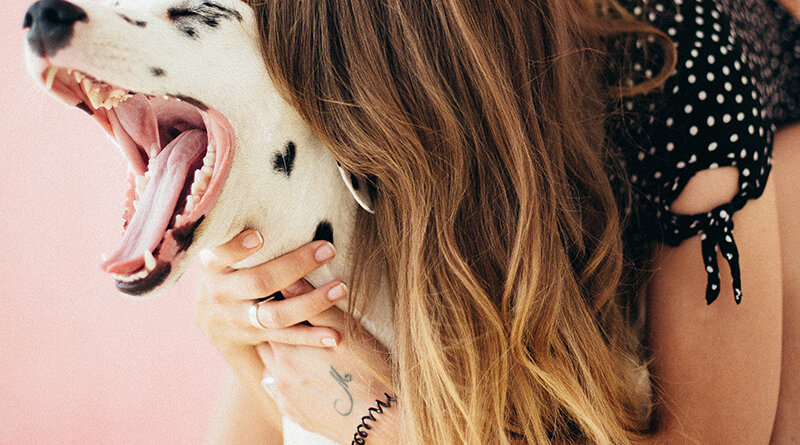Dog Patting: Why Doesn’t My Dog Like Getting Petted
“Oh, Pumpkin just loves petting, don’t you, Pumpkin?” Martha said, patting her Cocker Spaniel on top of his head as he tried to investigate the office. Pumpkin’s guardian had come to me for some advice about behavioral issues, and was clearly a woman who loved her dog as we all, human or dog, would like to be loved. Only one problem: Though Martha beamed with affection, Pumpkin didn’t seem quite so happy. In truth, he looked downright miserable. He kept turning his head away from Martha’s hand, trying to avoid her touch, no matter how loving it might have been.
This is not an uncommon scenario: a responsible, caring guardian pats a dog who purportedly adores it as the dog is moving heaven and earth trying to get away. Ask any dog trainer or behaviorist—we see it every day in the office, in classes and on neighborhood streets: people cheerfully patting their dogs, while the dogs look miserable.
Bear with me here. I’m not saying dogs don’t love to be petted. Most of them do. But then … they don’t. Honest. Dogs love petting and they don’t love petting, and both of those statements are equally true. Ironically, the explanation for that seeming contradiction lies in the behavior of those who are actually doing the petting.
Put yourself in your dog’s paws for a minute, and it will all make sense. Like most humans, you probably love a good back rub. Just thinking about one can make most of us smile. But you don’t want one every minute of every day, do you? What if you’re in an important meeting, about to argue against yet another ridiculous downsizing order from your boss? How about when you’re playing softball in the league’s quarter-finals? Want your honey rubbing your neck when you’re up to bat? I don’t think so. What if you do want a back rub, but your would-be masseuse pounds on the top of your head like a woodpecker? Feel good? Nope.
GET THE BARK IN YOUR INBOX!
Sign up for our newsletter and stay in the know.
My Dog Doesn’t Want To Be Touched
Dogs are just like us—their enjoyment of touch depends on when it’s offered, how it’s done and where on the body it’s directed. I’ll talk about context first, because it’s the variable that guardians most often ignore.
Do you want a massage right now? I don’t, I’m busy writing this column. And I don’t want one when I’m training my dog, giving a speech or trying to figure out why my computer does one of the inexplicable and irritating things it does when I’m in a hurry. But I’d love one later, when I’ve turned off the computer and the chores are done and I’m settled in for the night. Dogs are no different: They most enjoy being stroked during quiet times, when the pack is settled in, cozied up in the living room or bedroom, the outside world shut away for awhile. They enjoy being stroked least when they’re in high-arousal play mode. Watch a dog who is called away from an exuberant play session and is “rewarded” with a pat on the head—most will turn their heads and move away. I swear I can practically hear them saying “Awww … Mommmmmmm.” Neither do most dogs enjoy being patted while greeting other dogs, eating their dinner or otherwise engaged in something that requires concentration.
And, just like people, dogs vary tremendously when it comes to who they want to touch them. Some are veritable streetwalkers, happy to get cuddly with anything with hands, while others are uncomfortable having strangers touch them at all, at least on the first date. We generally expect dogs to tolerate being touched by anyone, but that doesn’t mean they like it. They’re just usually not in a position to do much about it.
Dogs are also like people in where they like to be touched. Their favorite places may be different than ours—I’ve yet to see a human go glaze-eyed and thump his leg when scratched above the tail bone—but we don’t enjoy it equally on every part of our body.
As I write this, the thought crosses my mind: Everyone knows this, why use up valuable space talking about it? And then I think of the thousands of times I’ve seen people slap their dog on top of the head, or hug the dog until his eyes begin to bulge, and I’m convinced that it still needs to be said. In general, dogs enjoy touch most on the sides of the head, under the ears and chin, on the chest, and at the base of the tail. Although some dogs will turn inside out for any touch at all, most don’t like their paws handled, aren’t fond of anyone messing around with their hind legs or genitals, and downright hate slappy pats on the top of their head. Of course, every dog—like every person—is different. Some people are particular about where they want to be touched, others are happy to make contact with another warm body any way they can.
How you pet your dog also makes a big difference, and individual preferences are again just as important in dogs as they are in people. In general, most of us enjoy gentle but firm strokes and rubs. I wish we’d use the words “rubbing,” “stroking” or “massaging” instead of “petting,” which is close enough to “patting” to cause no end of trouble. Patting, especially rapidly and repeatedly on top of a dog’s head, tends to put him off. (Remember this when your Border Collie drops the ball in your lap for the 560th time. You might as well use this to your advantage!)
This should not come as a big shock to individuals of our species—how much would you like it if a stranger walked up and patted you on the top of your head? In spite of that, people do it to dogs all the time. When I was taping the Animal Planet show Petline, a veterinarian-turned-sales rep asked to borrow Cool Hand Luke for a demonstration on dental care. Luke and I had just finished a segment in which I discussed how much dogs dislike being patted on top of the head, and had directed the audience’s attention to Luke’s look of disgust when we did it to him. Sure enough, after jerking Luke’s mouth open several times (as though she was cleaning clams), the women said, “Thank you, Luke,” and gave him three short, bouncy pats on the top of his head. We had to stop taping because the camera crew was laughing so hard they couldn’t continue filming.
When and how you pat your dog may seem like a trivial issue; I don’t expect to see it on CNN any time soon. But it’s actually an important one, given the amount of suffering that people and dogs experience when the relationship between them goes sour. Patting their dog’s head as a reward for a good recall, dog-lovers everywhere think they are using positive reinforcement, but what they are really teaching the dog—with stunning effectiveness—is not to come when called. Before you know it, the dog is at the local shelter because “he just won’t listen to me.”
Touch is vitally important to the physical and psychological health of both our species, and can even be used therapeutically, as TTouch practitioners and other skilled therapists are aware. We’ve learned the hard way that babies simply curl up and die if they are not touched, particularly during their first year of life, and I see little reason to believe that an animal as social as a dog would be any different.
Of course, comparing an animal with a human can be dangerous—heaven knows we’ve all heard the dire warning that the road to hell is paved with anthropomorphism (the attribution of human characteristics to animals or objects). However, the truth of the matter is that it can also serve us well. A few of us in science (including primatologist Frans de Waal and the late cognitive specialist Donald Griffin, for example) argue that we make as many mistakes about animals by not being anthropomorphic as we do in employing it as a strategy. The key is to be objective and analytical, and to use all the information we have about the species in question, along with our own perspectives, to try to understand the experience of another animal.
After all, we rarely know what’s going on in the heads of our own family, and they, at least, are members of the same species. But I’ll bet you don’t greet your spouse or partners with happy slaps upside the head, now do you?
So go ahead, put yourself in your dog’s place. Who knows, maybe turn about will be fair play—someday, dogs will find that special sweet spot that makes us grin like idiots and thump our hind legs.




